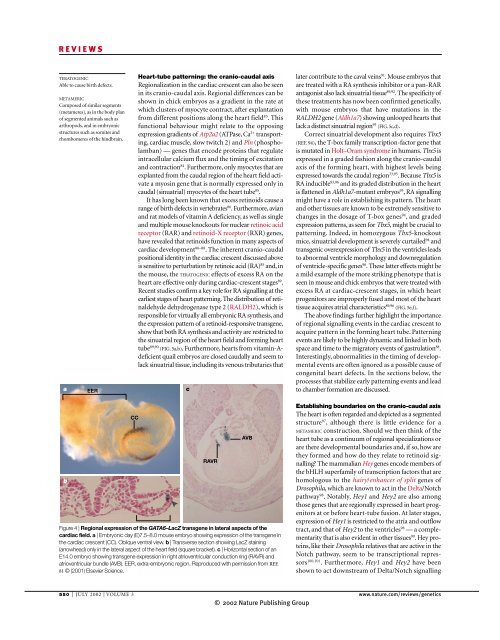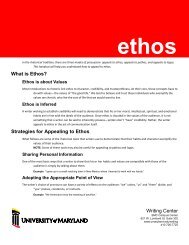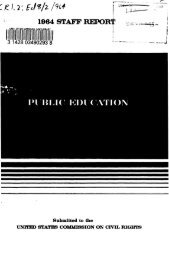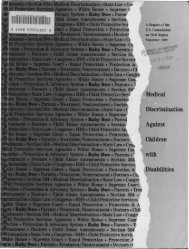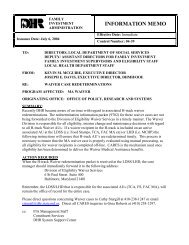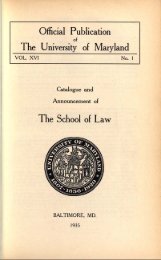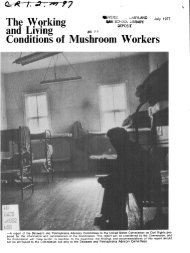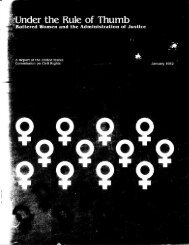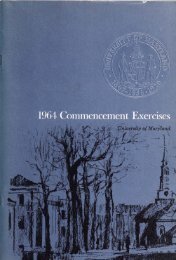PatterningHeartNatReviewsGen02.pdf
PatterningHeartNatReviewsGen02.pdf
PatterningHeartNatReviewsGen02.pdf
You also want an ePaper? Increase the reach of your titles
YUMPU automatically turns print PDFs into web optimized ePapers that Google loves.
REVIEWSTERATOGENICAble to cause birth defects.METAMERICComposed of similar segments(metameres), as in the body planof segmented animals such asarthropods, and in embryonicstructures such as somites andrhombomeres of the hindbrain.aEERHeart-tube patterning: the cranio-caudal axisRegionalization in the cardiac crescent can also be seenin its cranio-caudal axis. Regional differences can beshown in chick embryos as a gradient in the rate atwhich clusters of myocyte contract, after explantationfrom different positions along the heart field 83 . Thisfunctional behaviour might relate to the opposingexpression gradients of Atp2a2 (ATPase, Ca 2+ transporting,cardiac muscle, slow twitch 2) and Pln (phospholamban)— genes that encode proteins that regulateintracellular calcium flux and the timing of excitationand contraction 84 . Furthermore, only myocytes that areexplanted from the caudal region of the heart field activatea myosin gene that is normally expressed only incaudal (sinuatrial) myocytes of the heart tube 85 .It has long been known that excess retinoids cause arange of birth defects in vertebrates 86 . Furthermore, avianand rat models of vitamin A deficiency, as well as singleand multiple mouse knockouts for nuclear retinoic acidreceptor (RAR) and retinoid-X receptor (RXR) genes,have revealed that retinoids function in many aspects ofcardiac development 86–88 . The inherent cranio-caudalpositional identity in the cardiac crescent discussed aboveis sensitive to perturbation by retinoic acid (RA) 85 and, inthe mouse, the TERATOGENIC effects of excess RA on theheart are effective only during cardiac-crescent stages 89 .Recent studies confirm a key role for RA signalling at theearliest stages of heart patterning. The distribution of retinaldehydedehydrogenase type 2 (RALDH2), which isresponsible for virtually all embryonic RA synthesis, andthe expression pattern of a retinoid-responsive transgene,show that both RA synthesis and activity are restricted tothe sinuatrial region of the heart field and forming hearttube 89,90 (FIG. 5a,b). Furthermore, hearts from vitamin-Adeficientquail embryos are closed caudally and seem tolack sinuatrial tissue, including its venous tributaries thatclater contribute to the caval veins 91 . Mouse embryos thatare treated with a RA synthesis inhibitor or a pan-RARantagonist also lack sinuatrial tissue 89,92 . The specificity ofthese treatments has now been confirmed genetically,with mouse embryos that have mutations in theRALDH2 gene (Aldh1a7) showing unlooped hearts thatlack a distinct sinuatrial region 93 (FIG. 5c,d).Correct sinuatrial development also requires Tbx5(REF. 94), the T-box family transcription-factor gene thatis mutated in Holt–Oram syndrome in humans. Tbx5 isexpressed in a graded fashion along the cranio-caudalaxis of the forming heart, with highest levels beingexpressed towards the caudal region 33,95 . Because Tbx5 isRA inducible 93,96 and its graded distribution in the heartis flattened in Aldh1a7-mutant embryos 93 , RA signallingmight have a role in establishing its pattern. The heartand other tissues are known to be extremely sensitive tochanges in the dosage of T-box genes 94 , and gradedexpression patterns, as seen for Tbx5, might be crucial topatterning. Indeed, in homozygous Tbx5-knockoutmice, sinuatrial development is severely curtailed 94 andtransgenic overexpression of Tbx5 in the ventricles leadsto abnormal ventricle morphology and downregulationof ventricle-specific genes 96 . These latter effects might bea mild example of the more striking phenotype that isseen in mouse and chick embryos that were treated withexcess RA at cardiac-crescent stages, in which heartprogenitors are improperly fused and most of the hearttissue acquires atrial characteristics 89,96 (FIG. 5e,f).The above findings further highlight the importanceof regional signalling events in the cardiac crescent toacquire pattern in the forming heart tube. Patterningevents are likely to be highly dynamic and linked in bothspace and time to the migratory events of gastrulation 88 .Interestingly, abnormalities in the timing of developmentalevents are often ignored as a possible cause ofcongenital heart defects. In the sections below, theprocesses that stabilize early patterning events and leadto chamber formation are discussed.bCCRAVRFigure 4 | Regional expression of the GATA6–LacZ transgene in lateral aspects of thecardiac field. a | Embryonic day (E)7.5–8.0 mouse embryo showing expression of the transgene inthe cardiac crescent (CC). Oblique ventral view. b | Transverse section showing LacZ staining(arrowhead) only in the lateral aspect of the heart field (square bracket). c | Horizontal section of anE14.0 embryo showing transgene expression in right atrioventricular conduction ring (RAVR) andatrioventricular bundle (AVB). EER, extra-embryonic region. Reproduced with permission from REF.81 © (2001) Elsevier Science.AVBEstablishing boundaries on the cranio-caudal axisThe heart is often regarded and depicted as a segmentedstructure 97 , although there is little evidence for aMETAMERIC construction. Should we then think of theheart tube as a continuum of regional specializations orare there developmental boundaries and, if so, how arethey formed and how do they relate to retinoid signalling?The mammalian Hey genes encode members ofthe bHLH superfamily of transcription factors that arehomologous to the hairy/enhancer of split genes ofDrosophila, which are known to act in the Delta/Notchpathway 98 . Notably, Hey1 and Hey2 are also amongthose genes that are regionally expressed in heart progenitorsat or before heart-tube fusion. At later stages,expression of Hey1 is restricted to the atria and outflowtract, and that of Hey2 to the ventricles 98 — a complementaritythat is also evident in other tissues 99 .Hey proteins,like their Drosophila relatives that are active in theNotch pathway, seem to be transcriptional repressors100,101 . Furthermore, Hey1 and Hey2 have beenshown to act downstream of Delta/Notch signalling550 | JULY 2002 | VOLUME 3 www.nature.com/reviews/genetics© 2002 Nature Publishing Group


